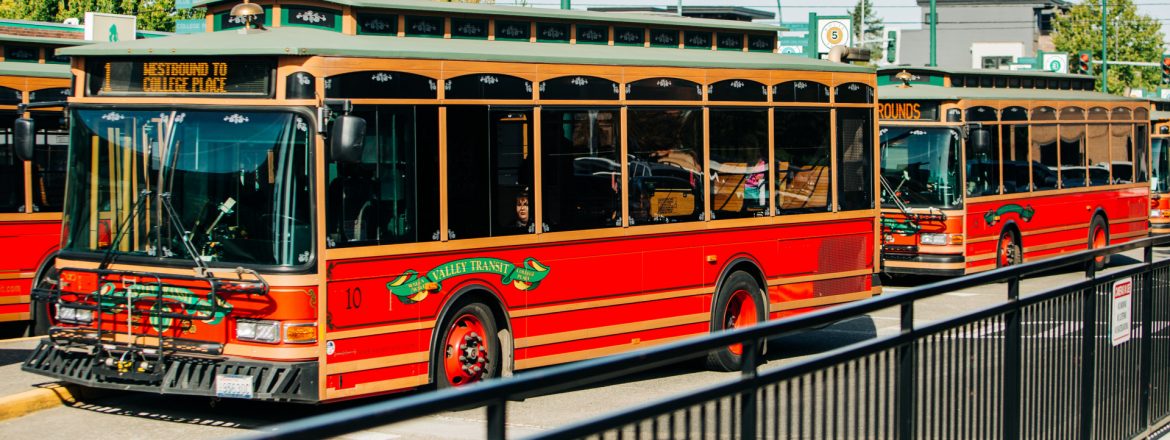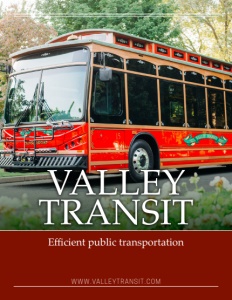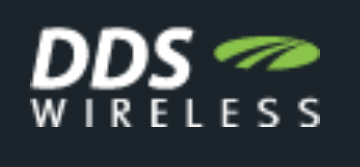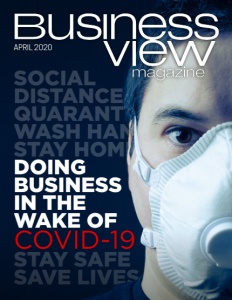Valley Transit
Efficient public transportation
Business View Magazine interviews representatives from Valley Transit, as part of our focus on best practices of municipal transportation organizations.
Valley Transit is a municipal corporation that provides public transit services in Walla Walla County, Washington. It was established in 1979 as a PTBA (Public Transit Benefit Area), encompassing the two school districts in the neighboring cities of College Place and Walla Walla. In 1980, a 0.3 percent sales tax was approved by voters to fund the system, which was matched by the State’s Motor Vehicle Excise Tax (MVET), allowing Valley Transit to begin operations in 1981.
In 2000, Initiative 695 repealed the MVET and cut funding for Valley Transit by roughly 53 percent of its operational funding at that time. However, it continued to operate with minimal service cuts for another nine years despite this loss. In 2009, lost MVET funding, paired with a rapid downturn in the economy, led Valley Transit to the choice between cutting services or pursuing additional funding. It chose to pursue a ballot measure for an additional 0.3 percent in sales tax funding, which was approved by the public by a margin of 76 percent, bringing Valley Transit back to its original funding level. This remains the highest approval rating for any local transit funding tax in the state of Washington. Currently, the total 0.6 percent sales tax accounts for about 80 percent of the agency’s budget; fares account for 4 percent; and the rest is made up with state and federal funding. Valley Transit has 55 employees, including drivers, in-house maintenance, and administrative staff.
Recently, Business View Magazine spoke with Angie Peters, Valley Transit’s General Manager, to find out more about the agency’s operations and its future plans. The following is an edited transcript of that conversation.
BVM: Can you talk about Valley Transit’s different services?
Peters: “We operate Fixed Route, Paratransit/Dial-a-Ride, Job Access, Van Pool, and Plus services. Our fixed Route runs 9 lines with 11 buses with our Main Line running four buses on it to maintain a 30-minute pulse from the transfer center in downtown Walla Walla. That is a fairly high frequency for an area with just over 50,000 people in it. We also have bike racks on all of our trolleys to encourage active lifestyles as well as using green transportation for first-mile/last-mile connections.
“Our Plus services run in the evening and on the weekends to extend service through a Deviated Fixed Route. The Plus services allow us to extend public transportation services to 14 ¾ hours a day during the week, as well as an additional 7 ½ hours on Saturday. Switching to a Deviated Fixed Route and Connector bus allows us to reduce our hourly operational cost significantly by using just three buses as opposed to eleven. Our Plus Services is a combination of Dial-a-Ride type Connector service and a Deviated Fixed Route. So, in the evening, after 5:45, we switch to that service and we run a deviated route, which essentially goes where the Main Line had been going during the day. However, it can deviate up to a quarter mile off-route to get someone closer to their destination. Then, we have the Connector that runs in the area to help people get to the transfer center to be able to access our Fixed Route services.
“Complementary to the Fixed Route, we have paratransit, which we call Dial-a-Ride service, with more accessible vehicles for people who are physically unable to use the Fixed Route due to a disability. It’s a life-line service for many people in our community, and largely believed to be the primary reason our community supported the sales tax funding that supports our operations.
With Stratagen© ADEPT dispatching system and continuous route optimization, we average between 100 and 150 rides per day on that service. We also have what we call an ‘honored citizen status’ and that is for anybody who is 70 years or older; they are also eligible to use the Dial-a-Ride system.
“The biggest difference between Dial-a-Ride and Fixed Route is that it’s an ‘origin and destination’ service. This means it is tailored to the level of need for the passenger and involves a range of services. Most passengers utilize door-to-door service, and those with a higher level of need utilize reasonable modifications so they can use Dial-a-Ride to get where they need to go. We cover all of Walla Walla and College Place with that service.
“We run Job Access, which operates outside of our regular hours; it takes people to and from work, or work necessitated child care. Then, during the hours when our regular services are running, those passengers switch to Fixed Route or Dial-a-Ride instead.
“We also operate Van Pool. Currently we have four of them, and they are all currently utilized by employees of the Army Corp of Engineers and travel to nearby dams for work. As long as a trip originates or ends in Walla Walla, people are eligible to use our Van Pool Service.
“Our Fixed Route averages 2,200 rides per day when combining rides from all 11 buses. Across all systems we provide about 700,000 rides a year; 30,000 of those are on Dial-a-Ride. Together, Van Pool and Job Access, provide roughly 14,000 rides to work for residents of Walla Walla County each year.”
BVM: Can you talk about how the system uses technology for the benefit of its riders?
Peters: “Valley Transit has the first fully CNG (compressed natural gas) fueled Dial-a-Ride fleet in the state. We have recently purchased electric trolleys, as well as the accompanying charging infrastructure. The remainder of our Fixed Route trolleys are diesel-fueled.
“We use Token Transit to allow passenger to purchase digital passes. We have both our Valley Transit website for passenger information, and the iTransitNW website for live bus tracking location information, as well as trip planning information. Additionally, we have an app, branded with Valley Transit’s logo, to give passengers quick and easy access to live GPS information on their phone.
“Our trolleys are all equipped with automated stop announcers. We have solar-powered, live bus tracking signs at two high traffic bus stops, and two monitors for this information that are powered by electricity at our transfer center. All of our vehicles have Stratagen mSlates, which are tablets the drivers use to get trip information, enter ridership information, and maintain some communication with base (though this is supplemented with 2-way radio communication).”
BVM: What’s the corporate culture like at Valley Transit?
Peters: “At Valley Transit we do engaging work. We have competitive pay, and great medical and retirement benefits. We work in an environment of fair and equal treatment, and we are a small agency, so we hire with growth in mind and opportunities provided. We are also right in the thick of navigating the ‘silver tsunami’ in our industry, which means our workforce is changing quickly as the old guard of the industry changes. So, there are a lot of opportunities to be a part of our future. For our operations department in particular, the day-to-day work flow is ever-changing, so it is always interesting. People who want to help and serve people are drawn to being part of our team.”
BVM: How do you market your services to the community?
Peters: “We utilize several channels to market. We work with our local newspaper quite a bit. We have also begun using social media in the last six months. We use our trolley branding as a marketing technique with local tourism. This pairs well with the fact that Walla Walla has an award- winning downtown that has a similar historic vibe to it. We leverage excellent videography opportunities for such a small area through a local marketing firm. We also participate in community events to raise awareness and teach/train about our services. Historically, we have been fare-free in the summer; this not only allows us to increase our visibility, but it enables us to leverage the small loss in fares for three months against increased ridership. By doing this we are also able to reach ridership benchmarks set in the Small Transit Intensive Cities (STIC) program, which in turn makes us eligible for significantly more funding than the fares we would have made during the summer.”
BVM: What are some of your plans for the system, going forward?
Peters: “Over the next year, we will be making several investments in our CNG system that will increase safety and extend the longevity of our infrastructure and thus our Dial-a-Ride fleet. We are also hoping to transition to a fully electric trolley fleet for Fixed Route. We currently have two electric trolleys in service and before the end of 2020, we will have a total of four electric trolleys on the road. Obviously, battery electric buses take quite a bit of money, and so that will be phased in over time as the current diesel trolleys meet the end of their useful life. We are also hopeful, though very early in the research process, to partner with Walla Walla Community College on a solar powered battery bank to support an induction charging pad for future battery/electric buses.
“We are also in the process of a regional coordination effort for trip planning and real-time information on bus locations. It’s a project we call iTransit Northwest. It connects Southeast Washington transit providers and Northeast Oregon transit providers on a single map, so that you can plan trips from as far as Grant County, Oregon up to the Tri-Cities, here in Washington. This project began as a way to visually connect all of the service providers meeting at the Valley Transit Transfer Center for passengers. At this time, Grape Line, a Washington Department of Transportation sponsored program; People Mover from Grant County, Oregon; Kayak from Mission, Oregon; Milton Freewater Public Transit; and Columbia County Public Transit all connect at the Valley Transit Transfer Center.
“Currently, Valley Transit is the only live data on that map; the rest of the agency’s routes are shown as static. However, People Mover has just approved to come on board, displaying live information. And Kayak, which is another provider in northeast Oregon, is in the process of doing the same thing. Our goal is to get that entire system to have live information sent through to the customer-facing platform to make trip planning and coordinating between services easier to do. We would like to see each provider have their own branded app through our platform to easily pass this information on to their day-to-day passengers as well.”
“We are early the process of a comprehensive system analysis to design change for our system over the next ten years. This will help us meet the changing needs and demands of our community. The Walla Walla area has grown significantly in the last ten years, and we have seen that a lot of our ride generators are either in different locations than they were the last time a major adjustment was made to our routes, or there are completely new businesses that are now ride generators. So, we’re going to work with a consultant to research if there are any areas where we can be delivering transit a little more efficiently, or if there are areas that we’re not currently giving enough service. This will help us make short term changes as well as plan more effectively for long term changes.”
BVM: What else would you like our readers to know about Valley Transit?
Peters: “Valley Transit has had a history of doing things first; we had the first trolleys with CNG on the market. We had the first ever Gillig Trolleys (and there are now over 200 across the country); we now have the first electric trolleys that are on the market. We believe in continuous improvement and actively innovating in our industry. We are focused on projects that not only make our operations sustainable, but help improve environmental sustainability in our area.
“We’re providing 700,000 rides a year in an area where the population is only 50,000, and it’s only a fraction of the population who requires access to these services. So, that demonstrates we’re being very efficient. We are focused on being innovative without being wasteful, so we can be on the cutting edge of changes in the industry and keeping up with how the world is changing around us.
“Most importantly though, we are focused on providing access to those who need it. We want to help make our community livable, vibrant, and environmentally sustainable. Everyone on our team is working to provide high quality and efficient public transportation services that are responsive to the needs of our entire community; promoting quality of life, and a healthy economy.”
AT A GLANCE
WHO: Valley Transit
WHAT: A municipal transportation corporation
WHERE: Walla County, Washington
WEBSITE: www.valleytransit.com
PREFERRED VENDORS
StrataGen – www.stratagen.com
Ready to optimize your transportation organization?
Over 400 million trips are booked, scheduled and dispatched annually through StrataGen, a DDS Wireless Company.
At StrataGen, we are committed to giving our customers the solutions needed to take advantage of disruptive change in the transportation industry. Trip costs, the increase in number of passengers utilizing on-demand transport and elevated expectations regarding travel needs and self-service tools has amplified the challenges on the road ahead. The good news is we have built the tools necessary to take advantage of this change.



